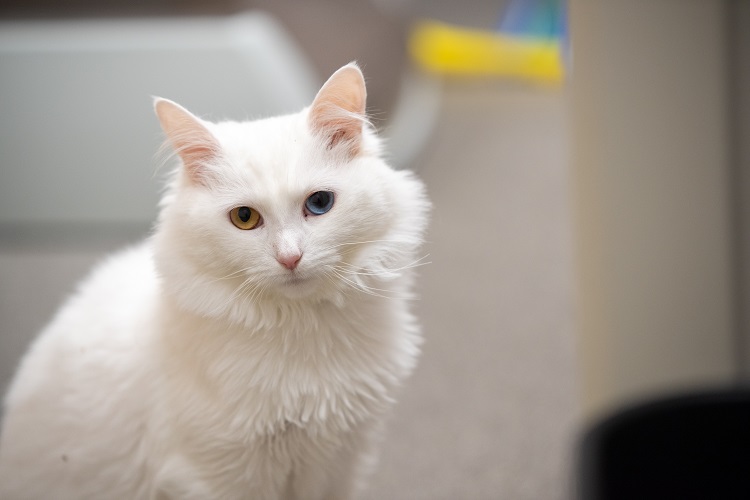Myth 1: Cancer is the end
Just because a patient is diagnosed with cancer doesn’t mean the end is here. There are so many treatment options available like chemotherapy, radiation therapy, surgery, and immunotherapy. Many pets are living longer with these new treatment options. Of course everyone is different, and each prognosis is treated differently. It’s worth having the patient visit an oncologist for a consultation and go from there.
Early detection is the best and there are so many new diagnostic tests that can be done to help get the pet on the right track. At my current hospital, we have patients that are in remission for over two years, some patients that came in really sick are now living their best life, and a few have needed thoracocentesis for the first few months and now don’t need it at all. My own dog was diagnosed with a grade II mast cell tumor at 12 years old. Her mast cell tumor was completely excised so I was lucky enough to just give her Benadryl® as needed. She is now 17 years old and has been doing well.
Myth 2: Chemotherapy will make my pet sick
Chemotherapy in pets is different than in humans. Every pet owner always wants to relate an experience they had with cancer, but we always remind them that dogs and cats are different. The amount of chemo is much less than in our human counterparts. Since canine and feline lifespans are about 12-15 years, veterinary oncologists are here to help prolong what life the patient has left. They try to make them feel as comfortable as they can to live a quality life. Can they get sick? Of course, but it tends to be some gastrointestinal upset – vomiting, diarrhea, decreased appetite. At day 3 of their treatment, they are usually feeling down, but generally they will bounce back fast. The veterinary oncologists will typically send home antinausea and antidiarrheal medication to have on hand just in case they need it at home.
With some chemotherapy medications, we give a pretreatment of antinausea medications. We do check a CBC with every chemotherapy appointment and at their nadir point (usually 7-14 days post treatment, when white blood cells are at their lowest). There are certain chemotherapy medications where we also check renal or liver panels. If a patient is getting doxorubicin, they also get an ECG to check for any cardiotoxicity. There are many things we do in veterinary oncology to ensure the patient remains healthy. In 15-20% of pets, they will experience mild to moderate side effects.
Myth 3: My pet will be bald after chemotherapy
Most dogs and cats have fur and not hair. Most patients do not go bald, but their fur can thin or shed a lot. There are breeds of dogs that have hair that continuously grows. Those patients tend to experience hair loss. Cats tend to lose their whiskers.
Myth 4: Now that my pet is on chemotherapy, I need to keep them separate from everyone else
Pets on chemotherapy can live in the household as normal pets. The amount of residual chemotherapy in urine, feces or saliva is so small that it isn’t going to harm another housemate. Chemo patients can eat, drink, and give kisses as normal. The only thing I tell clients is to keep anyone who is immunocompromised, pregnant or has children away from any accidents the pet may have in the house.
Myth 5: Feeding my pet a special diet will help prevent cancer
There isn’t a special diet that can help prevent cancer. There are studies that some supplements or vegetables can help keep cancer at bay or help improve the health of the pet. There is no need to change the pet’s diet once they are diagnosed. It is actually better to keep them on their original diet that they love. Some clients tell me that they are going to buy the most expensive food out there because it must be good for them. In reality, you want to feed the pet a diet that has research to back it up, ideally a food that has been around for years. Just because a food is expensive doesn’t mean it’s the best food out there.
Myth 6: Chemo is too expensive
Once the pet is diagnosed with cancer, the client should consult with an oncologist. There are many options out there to help different types of cancer. Many veterinary specialty hospitals have different payment options like CareCredit or Scratchpay. Some clients have set up GoFundMe pages or looked into different sites like the Animal Cancer Foundation. Many clients these days have pet insurance. Pet insurance has helped many families be able to treat their pets easier and without any money concerns.
Veterinary oncologists can give the client all the different options and estimates for those options so each family knows what they are looking at. Of course there are gold standard treatments out there, but there are also other options that work just as well to help make the pet feel better. Like I said before, pets unfortunately don’t live as long as humans, so we, in veterinary medicine, are here to help make the pet as comfortable as they can be for the time they have left with us. The majority of our chemotherapies are the same as the human chemotherapies with the exception of a few. Compounding these medications can also help with the overall cost. We also have options of clinical trials at certain hospitals or veterinary schools.
Myth 7: Oncology is depressing
Yes, a cancer diagnosis is scary and sad. We see young pets and old pets; age doesn’t discriminate in veterinary medicine. I would say the majority of the patients we see are aways so happy, wagging their tails, jumping for treats, giving kisses, and visiting all their friends throughout the hospital. So many of our clients tell us their pet loves coming to visit us. We give them the best experience they can have. We give them treats, comfortable beds to lie on during their treatment, hugs, and kisses too! We often hear how the pet’s demeanor is much better than it has been in the past and they are acting more like a puppy or kitten. Some days can be sad, especially if our longtime patient passes away, but I would say the majority of the days are always happy!
Share
Related blogs

The 8 Dimensions of Wellness

Marketing is All the Same, Right? Nope. 2 Ways to See the Differences

